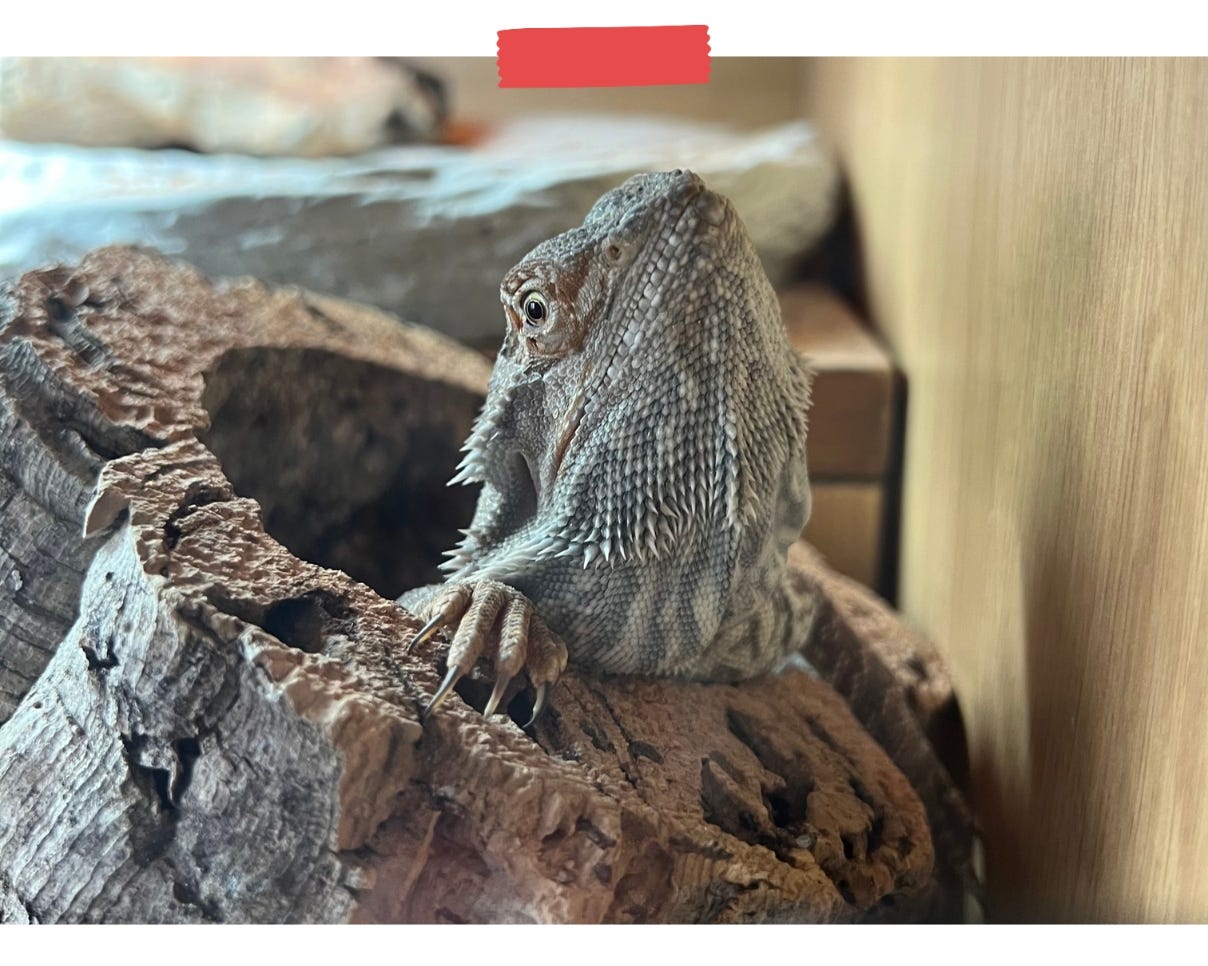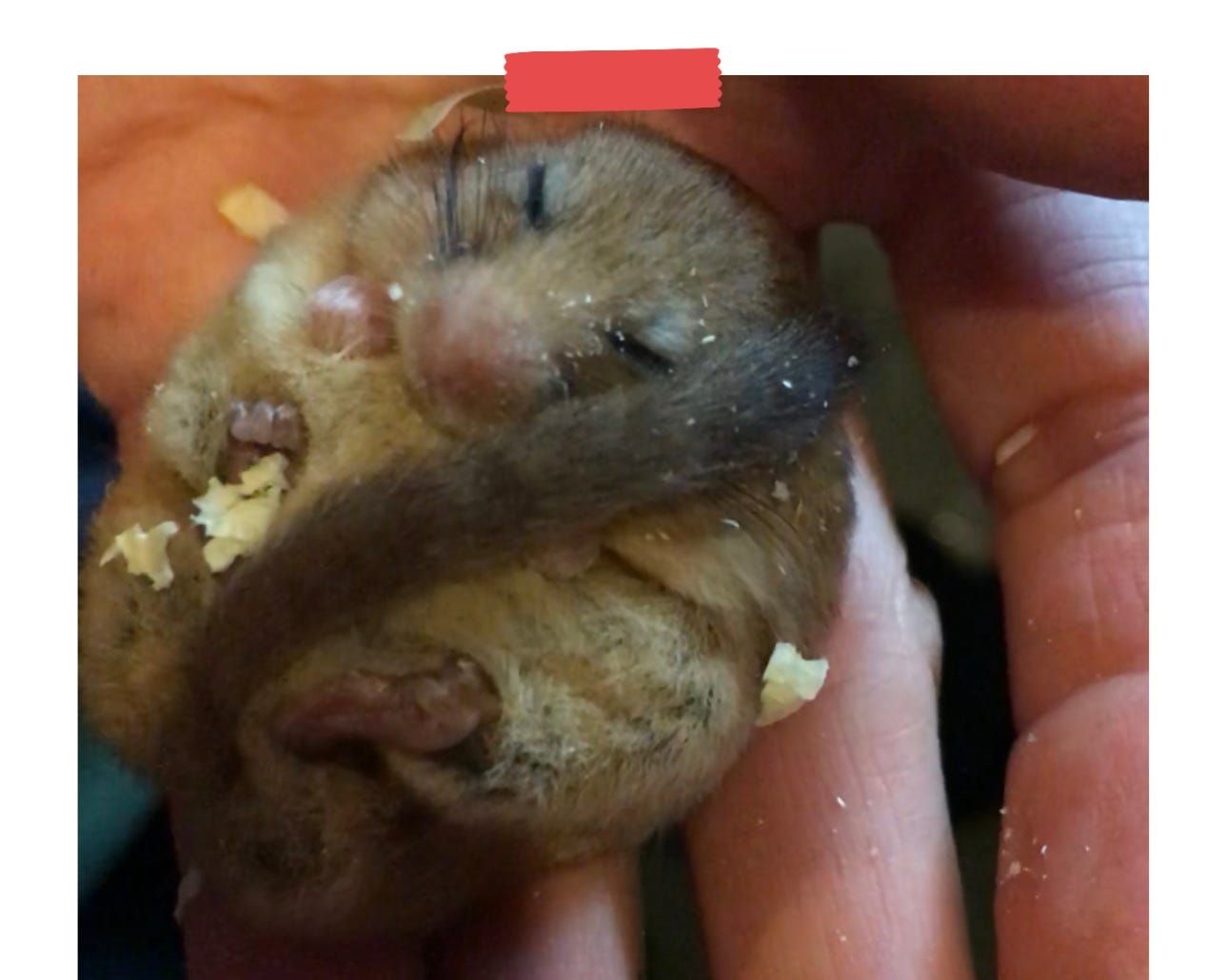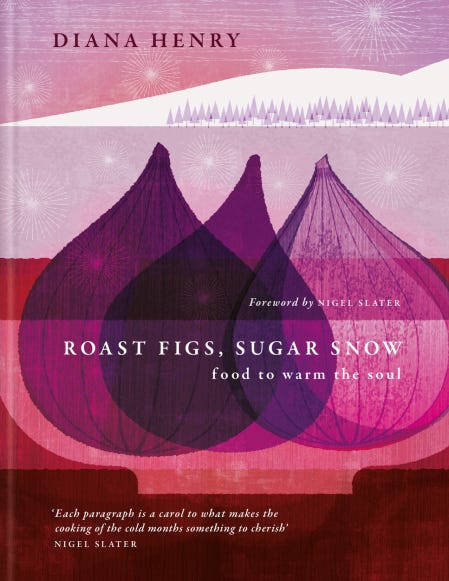Hello,
Tony, Bert’s pet bearded dragon, is entering brumation, the reptilian form of hibernation. It’s fascinating to witness. First of all he got plump, and I wondered whether I’d fed him too many worms. Then he got slower, strolling around his vivarium instead of scuttling, and spending a long time emerging from his hollow log each morning. He began to leave his carrot sticks, rather than crunching them down the minute I turned my back. It was hard not to read some kind of sadness into his behaviour, watching through my human eyes.
But Tony is not a human, and his body was undergoing something quite different. His drive to brumate is a survival response, aimed at seeing him through the winter months, when there is not enough sun to warm his cold blood. In his temperature-controlled enclosure, though, it was still a sweltering 35°C when he finally curled into a corner, wrapped his tail around his head and closed his scaly eyelids. His body remembered the rhythms of the year without ever feeling their evidence. We had to adjust the thermostat to match his behaviour.
One of my favourite research trips for Wintering (who am I kidding: of all time), was when I got to hold a hibernating dormouse. (Don’t worry, I didn’t disturb any wildlife: the dormice at the Wild Wood conservation centre are all rescued due to habitat disturbance or low body weight, and so they’re checked every few weeks to make sure they can make it through the whole winter; I just tagged along.) As this tiny form - about the size and shape of a golf ball, but far lighter - was placed in my hand, I experienced the peculiar alchemy of hibernation. Here was a creature so cold that it felt icy against my skin, and which appeared not to even be breathing; but at the same time, it was squishy with the liquid fat that it ekes out through its half-year of slumber, and, somehow, discernibly alive. There was something miraculous in witnessing this extreme boundary of life, this north face of survival.
As I write, we’re just a month away from the winter solstice, and my own body feels like it’s yearning to hibernate, too. The dark mornings make me want to burrow deeper under the covers, and the early evenings make sleep beckon from every corner. I experience a definite slowing at this time in the year, a distinct pull towards inactivity. It’s as though some unseen hand has reached into the universe’s control panel and increased inertia, adding an extra drag to each new action. I am being pulled inwards, towards slowness and stillness. Resistance is increasingly futile.
Humans, of course, do not actually hibernate; the only primate to do that is the fat-tailed dwarf lemur, which lives in Madagascar. But we do know that our bodies respond to colder weather and darker conditions in a variety of ways, including a thickening of the blood and an increase in body fat; some anthropologists think that prehistoric humans may have hibernated through the harshest months. Our contemporary tendency is to fight hard against our hivernal instincts, and to maintain the same, relentless activity levels the whole year through. We can barely imagine what our bodies would do if we let them. But if we look to nature - including our own biology - we can pick up some cues for a more restful winter.
Here are five ideas for embracing your own slowing at this time of year.
Abandon clock time
When the darkest part of the year arrives, we start craving our bed at what seems like a ridiculously early hour, often feeling ashamed and guilty for our dozing and yawning. But it’s only clock time that’s telling us our instincts are wrong; our bodies are continuing a pattern we’ve followed for millennia. I realise that the patterns laid out by work and school make it impossible to fully surrender to that 5pm bedtime, but we can make smaller adjustments to our sleeping patterns - particularly as recent research shows that it’s normal for us to sleep longer in the winter.
Instead of trying to impose an artificial system over the natural patterns of the year, adapt as much as you can to winter hours, by drinking in natural light during the day, and taking a moment to notice the dawn and dusk. This may well mean a sleepier winter, but you’ll also notice a balancing spike of energy in the summer.
Embrace the ‘watch’
Historian E. Roger Ekirch uncovers what went on during those long winter nights, before the advent of electric light. Not only did people sleep for longer, but they fell into a natural pattern of two sleeps with a long period of waking in the middle, sometimes known as ‘the watch’. This was seen as a very special part of the day, a quiet time that was free of the pressures of work or social life, in which people would talk with loved ones, write letters, pray, or have sex. In the more communitarian past, this afforded a rare moment of privacy and peace, and it was marked by a restful, contemplative quality of thought.
I find that my own sleeping pattern diverts to this in the winter, and I used to think it was insomnia before I learned to embrace it. Now, when I wake in the labyrinthine depths of the winter night, I pad downstairs, make a cup of rooibos tea, and read. After an hour or two, when I feel tired again, I go back to bed. When summer comes with its fleeting nights, I miss my midwinter watches.
Denning
There has long been a debate about whether bears undergo a full hibernation, or just periods of torpor where they sleep more and lower their body temperature during the coldest weather. The short answer is: they probably do both. But an interesting aspect of this is ‘denning’, which describes the behaviour of pregnant females who retreat to their den and stay there as their cubs are born. The mother is not sleeping, because she needs to care for her cubs; but instead, she creates a warm, safe space in which they can all rest together.
This is a useful idea for humans - the idea that we might retreat at our most fragile moments, cutting out external distractions in order to take the best care of ourselves. We cannot stay in our dens forever, but we can forgive ourselves when we need to retreat for a while - and even (whisper it) allow ourselves to take pleasure in that cosy time.
Make and mend
Long winter hours, trapped indoors by inclement weather, invite a different mode of doing. No longer in a hurry, we have time to sort through the detritus of the previous phase of life, to relinquish what we no longer need, to repair and restore what we want to keep. Winter is always industrious for me, but in a different way to summer: it’s a season when I am drawn to the slower crafts, the knitting and preserving, the polishing of treasured things.
There’s a long tradition of bringing greenery into the home at midwinter, branches of holly and pine, sprigs of ivy, berries from the rowan, spindle and hawthorne, pine cones and conkers. This is another slow practice, inviting care and attention, but it’s also an exchange with the wild, and part of the craft of maintaining a hibernation nest.
Think differently
Midwinter is a reflective time, a period of ruminative evaluation, a pause in the year which allows us to gather ourselves again. This might mean gestating new plans and imagining new lives, but it can have a keener edge, too. A space opens here to feel the kind of emotions that tend to get buried in the rush of the lighter months, the regret, the sadness, the grief. If you’ve never done so before, or have fallen off the wagon, this is the perfect time to open the pages of a journal (or as I prefer, the scruffiest notebook you can find), and pour it all out onto the page.
It’s also a time when thoughts merge with dreams, when the symbolism of the dying year collides with the birth of a new one. In our own brumation, we get the rare chance to dance with liminality, to drift between different worlds, and to make the imaginative leaps that will light the months to come. I can think of few things more enticing.
For a deeper exploration of the winter months - including more time with that dormouse - take a look at my book Wintering.
Take care,
Katherine
Coming up at The Clearing
Events for paid subscribers
December’s True Stories Book Club will be with Diana Henry talking about Roast Figs, Sugar Snow. Save the date: 19th December, 7pm UK
If you think a friend or loved one would enjoy The Clearing by Katherine May, gift subscriptions are available here | Website | Buy: Enchantment UK /US | Buy: Wintering UK / US | Buy: The Electricity of Every Living Thing UK / US
This newsletter may contain affiliate links.









This made my day. There is something so lovely about eating dinner earlier, as we do this time of year, and getting into pajamas right afterward. I am in bed before 10 most nights with a book. BLISS. Like your night watches, I miss this in the summer. All hail the Winter retreat! 💙💙💙
And I'm normally tucked up by 9 pm all year round, due to health condition. I feel less like I'm missing out in winter though!